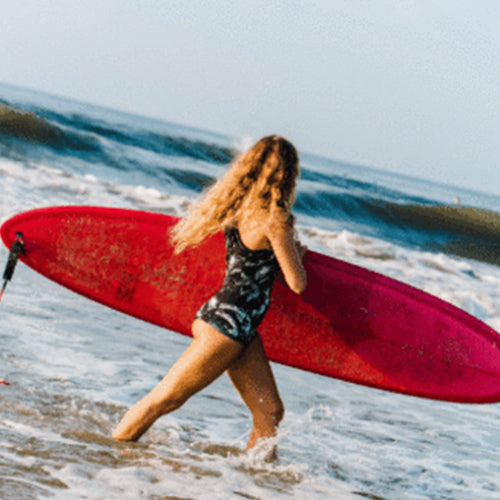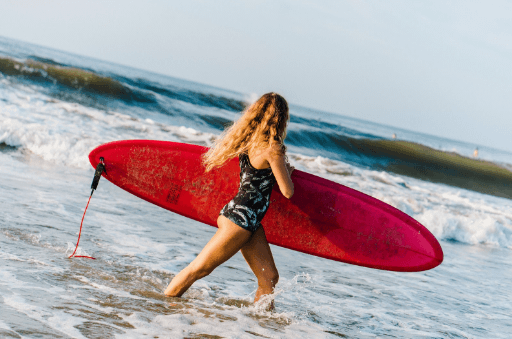
Finding that Sweet Spot
Share
Finding that Sweet Spot
So, you want to start surfing? It’s time to make way to the water! This post isn’t going to prep you for big wave surfing - it’s about getting comfortable with your surfboard in the ocean.
The “Sweet Spot”
Before you start paddling out looking for breaks, take a step back and start from the beginning. Make sure you’re looking for green surf conditions on Magicseaweed.com and small waves.
Tip: Magicseaweed is a great site to use for tracking the surf.
Once you find your surf day, practice paddling out past where the waves are breaking to the calm part of the ocean. As you paddle, check in with your body and where it sits on the surfboard.
You want to make sure the tip of your board isn’t submerging under water or pointing to the sky - your board should be parallel with the surface. What you’re doing is looking for your “sweet spot” - this is where you are balanced on the board and you have the least amount of drag slowing you down.
Make sure you aren’t setup too far left or right- you want your body to be vertically centered on the board- your nose aligning with the very tip of the surfboard. Visualize your Hamboard when you ride- it’s parallel with the road’s surface and you are centered horizontally to keep it from tilting left or right. This is what you want with your surfboard when you are paddling out.

The Surf Paddle
As you begin to paddle, make sure you aren’t shifting from left to right. You’ll need to engage your core and stay centered. As you paddle you’re trying to get the most force from every stroke so be sure to keep your hands flat and relaxed so you can create as much resistance as possible- they should not be cupped or balled into fists.
Focus on reaching your arms deep into the water - a shallow paddle will have much less surface area so you won’t get as much “bang for your buck”.
You also want to keep your stoke tight in on the board and not out wide to the sides. You’re reaching as far forward, straight ahead as you can and then pulling and pushing that water straight back along the edge of your board.
Aaaaaand practice. Find a clear demarcation of a route to paddle back and forth to (in between two jetties or to a buoy and back) and start taking some laps. As you paddle, you may find that if you even slightly shift your weight a bit further forward or backward it may improve your speed.
What you want to do is make sure that you know exactly where that sweet spot is and that you’ve mastered your stroke so that when it comes time to catch waves your arms will know what to do.
Tip: To build up arm strength, core strength and stamina go on some long Hamboard rides with the Land Paddle.
Make it Wavy
Once you have your surf stroke and sweet spot down, it’s time to practice paddling out through waves from the beach. The best way to start is on a day with smaller waves so you can paddle over top of them.
When you’re on the beach start to watch the waves and their timing. You’ll want to pick your moment to paddle out and ideally, that’ll be when the least amount of waves are coming through (in between a set). When you push up over a small and/or unbroken wave your hands are going to grip the edges of your surfboard (known as the rails).
Tip: Use your yoga.
If you have any background in yoga, it’s sort of like a surf version of upward facing dog. Your arms lengthen, bringing your upper body off of the board as you bring the weight of your lower body either onto your knees or your toes.
The goal is to keep your board as stable as you can and as parallel as possible. Once the wave passes, you lower back down to that sweet spot and continue to paddle out.

Wave Reader
As you continue to go out and surf and you become more comfortable with paddling out you’ll start to get the transition down smoothly. You’ll also start to read the waves for timing. When your making your way out and you see a wave coming that hasn’t broken yet you’re going to want to paddle as hard as you can to make it over before it breaks - this way it’s just a hump to paddle over than white water that you’ll need to get past.
If the wave is too big to paddle over once it’s broke you’ll need to either bust through the peak, duck dive or turtle. Hopefully you don’t find yourself messing with big waves early on. The key to learning how to surf is to make sure you’re having fun. Pick appropriate days to go out and practice your skills.
As you head out to the water I hope these tips come in handy! We’d love to hear about your first time heading out to surf and how it went. If you’ve found these pointers helpful please share this post!
Written by Dominique (Nico) Klimek // @neeks.peeks
